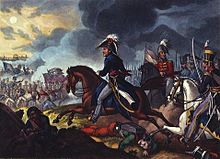
Back معركة شلمنقة Arabic Emgann an Arapiles Breton Batalla dels Arapiles Catalan Schlacht bei Salamanca German Batalla de los Arapiles Spanish Arapilesko gudua Basque Bataille des Arapiles French Batalla de Arapiles Galician קרב סלמנקה HE Battaglia di Salamanca Italian
This article includes a list of general references, but it lacks sufficient corresponding inline citations. (July 2011) |
| Battle of Salamanca | |||||||||
|---|---|---|---|---|---|---|---|---|---|
| Part of the Peninsular War | |||||||||
 Wellington at Salamanca by William Heath | |||||||||
| |||||||||
| Belligerents | |||||||||
|
| |||||||||
| Commanders and leaders | |||||||||
| Strength | |||||||||
| 42,000[1]–49,647[2] | 46,000[1]–51,949[3] | ||||||||
| Casualties and losses | |||||||||
|
Up to 6,000[4]–10,000[1] killed or wounded and 7,000 captured[4][1] Total casualties:12,000[5]–17,000 killed, wounded or captured |
United Kingdom: 3,129 killed, wounded or captured Portugal: 2,038 killed, wounded or captured Spain: 6 killed, wounded or captured Total casualties: 5,000[5]–5,200[1] killed, wounded or captured | ||||||||

125miles

The Battle of Salamanca (in French and Spanish known as the Battle of the Arapiles) took place on 22 July 1812. An Anglo-Portuguese army under the Earl of Wellington defeated Marshal Auguste Marmont's French forces at Arapiles, south of Salamanca, Spain, during the Peninsular War. A Spanish division was also present but took no part in the battle.
The battle involved a succession of flanking manoeuvres in oblique order, initiated by the British heavy cavalry brigade and Pakenham's 3rd Division and continued by the cavalry and the 4th, 5th and 6th divisions. These attacks resulted in a rout of the French left wing. Marmont and his deputy commander, General Bonet, received shrapnel wounds in the first few minutes of firing. Confusion amongst the French command may have been decisive in creating an opportunity, which Wellington seized.
General Bertrand Clauzel, third in seniority, assumed command and ordered a counter-attack by the French reserve toward the depleted Allied centre. The move proved partly successful but with Wellington having sent his reinforcements to the centre, the Anglo-Portuguese forces prevailed.
Allied losses numbered 3,129 British and 2,038 Portuguese dead or wounded. The Spanish troops took no part in the battle as they were positioned to block French escape routes and suffered just six casualties. The French suffered about 13,000 dead, wounded and captured. As a consequence of Wellington's victory, his army was able to advance to and liberate Madrid for two months, before retreating to Portugal. The French were forced to abandon Andalusia permanently while the loss of Madrid irreparably damaged King Joseph's pro-French government.
- ^ a b c d e f Bodart 1908, p. 432.
- ^ Gates 2002, p. 514.
- ^ Gates 2002, p. 513.
- ^ a b Gates 2002, p. 358.
- ^ a b Eggenberger 1985, p. 379.